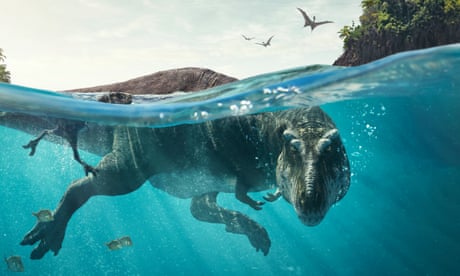A “dinosaur revolution” is taking place with a new species being discovered every week, the makers of a groundbreaking new docuseries exploring life on Earth 66m years ago have said. Prehistoric Planet, produced by BBC Studios’ Natural History Unit and premiering on Apple TV on Monday, is narrated by Sir David Attenborough and features original music composed by the multiple Oscar winner Hans Zimmer. The show brings together huge names from across the industry including the executive producers Jon Favreau, who has been involved in a string of Hollywood blockbusters including the Marvel Cinematic Universe films, and Mike Gunton, whose previous credits include the Bafta and Emmy-winning documentary Planet Earth II. Gunton told the Guardian the five-part series combines wildlife film-making, the latest discoveries in palaeontology and cutting-edge CGI technology to recreate the dinosaurs that inhabited Earth, in a one-of-a-kind immersive experience. “The late Cretaceous period is a whole extraordinary world we haven’t turned our natural history cameras on,” he said. “This was an incredibly diverse, rich time of life. We tend to be very focused on today, but the animals that lived during that period were complex, sophisticated creatures. They were marvellous and miraculous.” The Isle of Wight’s dinosaur hunter: we’re going to need a bigger museum Read more Darren Naish, the show’s consultant palaeontologist, said it was the perfect time to make a show that explored how dinosaurs lived, including the relationships between them. “What’s key is we’re in the middle, right now, of a dinosaur revolution,” he said. “Since the 1990s there’s been an enormous surge in number of new species being discovered, with around about a new dinosaur species discovered every week. That’s more than 50 a year. No one can keep up with this.” In China, Naish said, researchers have discovered soft tissues on dinosaur remains – skin, feathers, fossil eyeballs and fossil lungs. This, combined with modern technology, allows for new takes on the creatures’ biology, behaviour and evolutionary history, he said. “For example, T rexes must have courted to make babies, but how did they actually go through the courtship?” For the series, they used a technique called phylogenetic bracketing, which takes into account the family tree of the animals. “For a dinosaur like Tyrannosaurus, it’s surrounded on one side by crocodiles and alligators and on the other side birds, which are living dinosaurs. You look at what’s present in those species and if there’s similarities, you can sensibly infer that for your extinct animal as well.” The more we learn about the past, he said, the better we can understand the present and future. “Everyone involved in science is aware of the climate crisis and the human impact on the planet. You can say that the particular things that made the Cretaceous world the way it was, like high CO 2 levels, loads more water vapour in the atmosphere, therefore higher sea levels and less ice, is the world we are actually creating now through our own actions. “It was great for dinosaurs and seagoing reptiles. Sea levels were tens of metres higher, all of the low coastal areas like the whole of western Europe were flooded, North America was split in two by a sea.” Gunton said the fact that such extraordinary creatures as dinosaurs are no longer with us was sobering. “It reminds you of the fragility of the planet, that we hold on by our fingertips because mother nature is much more powerful. It also reminds you of the planet’s resilience. As one door shuts, evolutionarily, another opens,” he said.
From: theguardian
URL: https://www.theguardian.com/science/2022/may/20/attenborough-series-sinks-teeth-into-fruits-of-dinosaur-revolution
